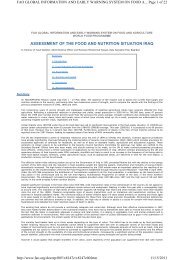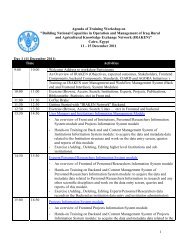Vermiculture in Egypt: - FAO - Regional Office for the Near East and
Vermiculture in Egypt: - FAO - Regional Office for the Near East and
Vermiculture in Egypt: - FAO - Regional Office for the Near East and
Create successful ePaper yourself
Turn your PDF publications into a flip-book with our unique Google optimized e-Paper software.
vermicast<strong>in</strong>gs produced per crop is 21,840 kg based on a production of 420 kg/plot<br />
(from 600 kg x 70% recovery). The total gross production of earthworm biomass per<br />
crop is 468 kg, based on a yield of 9 kg/plot (from <strong>the</strong> 3 kg starter <strong>and</strong> 6 kg of biomass<br />
ga<strong>in</strong>). At <strong>the</strong> sell<strong>in</strong>g price of 0.11$/kg of vermicast<strong>in</strong>gs <strong>and</strong> 0.22$/kg <strong>for</strong> <strong>the</strong><br />
earthworms biomass, gross sales <strong>for</strong> one crop cycle is estimated at 2356.11$ <strong>and</strong><br />
1035.62$, respectively. This would provide <strong>the</strong> venture a net profit of around 742.73$<br />
every 2 months, <strong>and</strong> a rate of return of 249.83% annually. The study suggests a<br />
potential <strong>for</strong> develop<strong>in</strong>g <strong>the</strong> use of earthworms <strong>in</strong> farm-made moist feeds. Such type<br />
of feed is simple to produce <strong>and</strong> is proven to work well when properly <strong>for</strong>mulated <strong>and</strong><br />
processed. In as much as <strong>the</strong> production technology <strong>for</strong> earthworm farm<strong>in</strong>g can be<br />
readily adopted at <strong>the</strong> village level, where organic raw materials abound <strong>and</strong> where<br />
labor is cheap.<br />
3.2 Vermicompost<strong>in</strong>g <strong>in</strong> Cuba<br />
In Cuba, different methods are used <strong>for</strong> worm propagation <strong>and</strong> vermicompost<strong>in</strong>g. The<br />
first <strong>and</strong> most common is cement troughs, two feet wide <strong>and</strong> six feet long, much like<br />
livestock water<strong>in</strong>g troughs, used to raise worms <strong>and</strong> create worm compost. Because of<br />
<strong>the</strong> climate, <strong>the</strong>y are watered by h<strong>and</strong> every day. In <strong>the</strong>se beds, <strong>the</strong> only feedstock <strong>for</strong><br />
<strong>the</strong> worms is manure, which is aged <strong>for</strong> about one week be<strong>for</strong>e be<strong>in</strong>g added to <strong>the</strong><br />
trough.<br />
First, a layer of three to four <strong>in</strong>ches of manure is placed <strong>in</strong> <strong>the</strong> empty trough, <strong>the</strong>n<br />
worms are added. As <strong>the</strong> worms consume <strong>the</strong> manure, more manure is layered on top,<br />
roughly every ten days, until <strong>the</strong> worm compost reaches with<strong>in</strong> a couple <strong>in</strong>ches of <strong>the</strong><br />
top of <strong>the</strong> trough, about two months. Then <strong>the</strong> worms are separated from <strong>the</strong> compost<br />
<strong>and</strong> transferred to ano<strong>the</strong>r trough.<br />
The second method of vermicompost<strong>in</strong>g is w<strong>in</strong>drows, where cow manure is piled<br />
about three feet across <strong>and</strong> three feet wide, <strong>and</strong> <strong>the</strong>n it is seeded with worms. As <strong>the</strong><br />
worms work <strong>the</strong>ir way through it, fresh manure is added to <strong>the</strong> end of <strong>the</strong> row, <strong>and</strong> <strong>the</strong><br />
worms move <strong>for</strong>ward. The rows are covered with fronds or palm leaves to keep <strong>the</strong>m<br />
shaded <strong>and</strong> cool. Some of <strong>the</strong>se rows have a drip system - a hose runn<strong>in</strong>g alongside<br />
<strong>the</strong> row with holes <strong>in</strong> it. But mostly, <strong>the</strong> rows are watered by h<strong>and</strong>. Some of <strong>the</strong>se<br />
rows are hundreds of feet long. The compost is ga<strong>the</strong>red from <strong>the</strong> opposite end when<br />
<strong>the</strong> worms have moved <strong>for</strong>ward. Then it is bagged <strong>and</strong> sold. Fresh manure, seeded<br />
with worms, beg<strong>in</strong>s <strong>the</strong> row <strong>and</strong> <strong>the</strong> process aga<strong>in</strong>. Some of <strong>the</strong> w<strong>in</strong>drows have bricks<br />
runn<strong>in</strong>g along <strong>the</strong>ir sides, but most are simply piles of manure without sides or<br />
protection. Manure is static composted <strong>for</strong> 30 days, <strong>the</strong>n transferred to rows <strong>for</strong><br />
worms to be added. After 90 days, <strong>the</strong> piles reach three feet high. It has been reported<br />
that worm populations can double <strong>in</strong> 60 to 90 days.<br />
28





